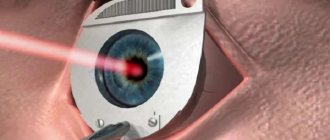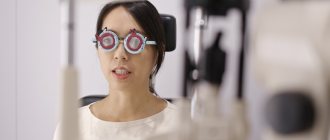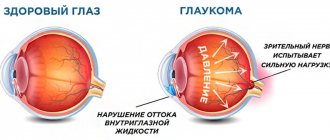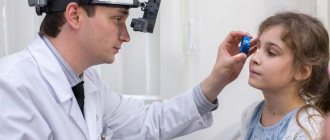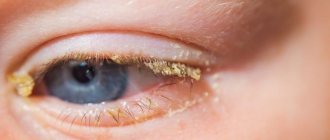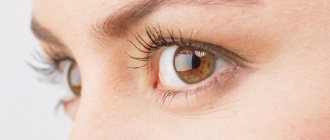Age-related farsightedness is an eye condition in which it is difficult for a person to distinguish objects at close range. Sooner or later everyone develops it.
Translated from Greek, the name means “old eye”; it occurs even in those who have always had good and healthy vision.
There is a myth about farsightedness that once you start wearing reading glasses, your vision will rapidly deteriorate. For this reason, those who believe in this myth try to go without glasses for as long as possible, which only worsens their situation and accelerates the manifestation of presbyopia.
The difference between presbyopia and farsightedness
Although presbyopia is farsightedness, there are significant differences between these visual impairments.
In this article
- The difference between presbyopia and farsightedness
- Presbyopia: causes and symptoms
- Correcting presbyopia with glasses
- Choosing contact lenses for presbyopia
- Is it possible to get rid of age-related farsightedness surgically?
- Prevention of age-related farsightedness
Presbyopia develops as a result of natural aging of the body when the lens of the eye loses its elasticity and occurs in people of mature age (after 40 years).
Normal farsightedness is not caused by age and can occur even in children. The reason for the development of hypermetropia is a violation of the refractive power of the eye or a shortened shape of the eyeball. It is worth noting that in a person with hypermetropia, presbyopia may occur 5-10 years earlier than in people with normal vision. You can get rid of farsightedness, which is not associated with age-related changes, using laser correction, installation of phakic lenses, or refractive lens replacement. These operations, if indicated, can be performed up to 45 years inclusive. Farsightedness can be corrected with plus glasses or contact lenses at almost any age.
Restoring vision with age-related farsightedness is a more difficult task, because after 40 years it is impossible to stop the aging process of the body.
Reasons for the development of farsightedness after 40-45 years
Why does pathology most often develop at this age? The appearance of presbyopia in adults 40 years of age or more is associated with a gradual weakening and then complete loss of elasticity of the lens, a biconvex natural lens, as well as changes in its size, consistency, weight and even color, which is associated with its growth, chemical, biological characteristics and shifts. A decrease in the accommodative ability of a natural lens with farsightedness in adults (elderly) is also associated with a decrease in the ability of the ciliary muscle to contract.
In addition to the key age-related causes of age-related farsightedness, there are additional factors influencing its occurrence. These include:
- diabetes;
- atherosclerosis;
- high blood pressure;
- avitaminosis;
- inflammatory pathologies of the visual organs (keratitis, blepharitis; uveitis, conjunctivitis);
- mechanical eye injuries;
- regular excessive load on the visual system;
- alcohol intoxication of the body;
- surgical intervention.
Presbyopia: causes and symptoms
The condition of the visual system of a person over 40 years of age, in which near vision is impaired and difficulties arise when reading and doing work at close range, is called presbyopia. With this disorder, people find it difficult to read small print, especially in poor lighting, so they have to move the book away from their eyes at arm's length or use a magnifying glass. This is why presbyopia is called “long arm disease.”
Age-related farsightedness has natural causes. The lens of the eye, which is responsible for focusing our vision at different distances, loses its elasticity with age. It becomes denser and cannot, as before, easily change its curvature. Age-related changes in the lens lead to the fact that human eyes lose the ability to accommodate and cannot clearly focus on nearby objects.
Also, as the body ages, the muscles that hold the lens weaken and can no longer change its shape to focus the image on the retina. As a result, a person with presbyopia sees nearby objects blurry and unclear. In addition to blurry near vision, other symptoms of presbyopia include difficulty reading and writing, increased eye fatigue, and frequent headaches.
How to deal with age-related hypermetropia
Presbyopia is a common, natural condition that occurs as part of the aging body. Therefore, no matter how much a person takes care of his vision for many years, in old age the disorder will manifest itself to one degree or another. But this does not mean that it should not be treated.
There are several methods for treating senile farsightedness:
- spectacle correction,
- contact lenses,
- laser thermokeratoplasty,
- lens replacement surgery.
- Wearing glasses is the simplest, most accessible method. The doctor prescribes glasses. They are intended for reading, helping a person to see the text normally. This type of optics has glass that is split in half. The upper part is designed to look into the distance, and with the help of the lower part it is convenient to examine objects close up and read.
- With the help of lenses, a person can clearly see all objects in different states. Multifocal progressive lenses with good gas penetration are suitable for such patients.
To restore vision without glasses, several types of operations are used, including laser thermokeratoplasty and lens replacement surgery.
- Thermokeratoplasty allows the surgeon to change the curvature of the cornea in one of the visual organs. This causes stimulation of monovision, where one eye sees near and the other sees far. This is an excellent way out of the situation, but not all patients get used to it. Therefore, before agreeing to such an intervention, you need to weigh everything carefully.
- Lens replacement is a radical treatment method that has some risks for the patient. However, if farsightedness is complicated by cataracts, then such treatment is most relevant. By replacing the lens, you can cure not only farsightedness, but also disorders such as myopia or astigmatism.
To choose the most effective treatment method, you should be examined and consult an ophthalmologist. The doctor will advise the right solution based on the specific characteristics of the patient’s body.
A disease that occurs in old age cannot be ignored. Such ignoring of the situation will lead not only to the fact that the person will have poor vision, but also to other health problems.
If cataracts develop against the background of the disease, then this combination can deprive a person of vision, so in no case should the problem be ignored or left unattended. The fact that senile farsightedness is normal does not exclude the fact that the disease must be treated.
Is it possible to get rid of age-related farsightedness?
There is still no cure for aging, which means that natural changes in the eye lens are inevitable, so presbyopia will manifest itself in any case. This condition is irreversible, but can progress at different rates, depending on the individual. As a rule, in a person with normal vision, the process of deterioration begins at the age of 40. On average, 40-year-old people need correction of +1 diopters; by the age of 50, vision deteriorates to +2 diopters; by the age of 60, to +3 diopters. These are average indicators typical for the vast majority of people with normal vision. Of course, there are exceptions when a person at the age of 60 has a solid “one” in vision or, conversely, senile changes begin early and progress quickly.
It is impossible to get rid of farsightedness once and for all, but correcting vision and eliminating unpleasant symptoms is possible and necessary.
Correcting presbyopia with glasses
Effective vision restoration for age-related farsightedness is possible under the supervision of an experienced ophthalmologist. Only a doctor, after a thorough diagnosis, will be able to choose the optimal method for correcting presbyopia. Spectacle optics are widely used by older people with presbyopia. One option is reading glasses, which improve near vision. The second correction method is bifocal glasses with two focuses. In this type of spectacle lenses, the lower part is responsible for near vision, and the upper part is responsible for distant vision. The most modern type of glasses for presbyopia are progressive. They operate similarly to bifocal models, but have a smooth transition between far and near vision zones, providing good vision at any distance.
Choosing contact lenses for presbyopia
People who are at an active age (40-60 years) prefer to use contact lenses to correct their vision. They allow you to lead a normal lifestyle, provide good quality central and peripheral vision, and are invisible from the outside. There are special multifocal lenses to correct presbyopia. They have at least two optical zones, one of which allows you to see clearly at close range, and the other at long range. Modern models of multifocal lenses also have an intermediate optical zone, which provides a smooth transition between near and distance vision. In such models of contact optics, a person sees well at any distance. Every year, more and more people after 40 years of age choose contact lenses to restore clarity of vision with farsightedness. They have many advantages over bifocals:
- provide a wide viewing angle and good lateral vision;
- in modern lenses, when looking from one object to another, a person does not experience discomfort;
- Multifocal lenses do not spoil the appearance and are invisible to others.
Acuvue 1-Day Moist Multifocal from Johnson & Johnson, Air Optix Aqua Multifocal from Alcon and Biofinity Multifocal from CooperVision. You can purchase lenses to correct age-related farsightedness only with a prescription from an ophthalmologist, so as not to make a mistake with the parameters.
Vitamins and drops
All organs require certain elements to function effectively, and if one of them does not receive enough substances, then the entire system will be disrupted. Therefore, when correcting nutrition, you need to take into account the body’s daily need for healthy supplements. But only some of them are necessary for visual acuity. Drops to improve vision for myopia are presented here.
What elements are needed for vision:
- unsaturated fatty acids;
- essential amino acids;
- carotenoids;
- vitamins A, E, C;
- chromium;
- potassium;
- B vitamins.
If the diet is poor or lacks a certain element, then you can take special supplements containing the missing vitamin.
But it is important to remember that many compounds have a maximum application limit, exceeding which causes poisoning and disruption of internal organs. Therefore, medications should be used only in recommended dosages so as not to worsen your health. You can find out about Oksial drops here. In addition to vitamins, special drops are also produced for the eyes. They are divided into two categories:
- Moisturizing - the composition is as close as possible to human tears, which allows you to maintain the cornea of the eye in normal condition if the lacrimal glands are not able to produce enough fluid. Some of the most popular are Visine, Pure Tear and Systane Ultra.
- Medicinal - contain drugs that affect eye diseases, often used together with drugs taken orally or parenterally. Very common ones are Vita Iodurol, Albucid, Taufon.
All medications should be taken only as prescribed by a doctor and in recommended doses. Self-medication can worsen vision if the cause of the discomfort was determined incorrectly.
Is it possible to get rid of age-related farsightedness surgically?
It is not possible to surgically restore the elasticity of the lens, but there are methods that help correct vision and stop using glasses or contact optics.
Laser thermokeratoplasty.
The method is based on the thermal effect of radio waves, with the help of which the refractive surgeon changes the shape of the patient's cornea. For age-related farsightedness, the procedure is most often performed on one eye to “tune” it to good near vision. This is the same as monovision, but without the use of glasses or contact lenses.
Replacement of the lens with an intraocular lens.
This method of treatment is the most radical and is most often used when presbyopia is accompanied by cataracts. Also, this method can be considered as the prevention of cataracts, because the artificial lens, unlike the real one, cannot become cloudy.
Modern technologies make it possible to perform such operations under local anesthesia through a minimal self-sealing incision that is closed without stitches. The procedure lasts about 20 minutes, and the patient usually goes home the same day. Multifocal or accommodating intraocular lenses are usually used to correct presbyopia. The first, by analogy with multifocal contact lenses, have several optical foci, allowing a person to see well at different distances. The second has a special “moving” design that uses the muscles of the eye and reliably imitates the focusing ability of the natural lens.
PresbyLASIK.
This is the latest method of treating age-related farsightedness, which is based on the use of an excimer laser. With its help, the surgeon models the surface of the cornea such that different areas of the eye will have different optical powers. An ophthalmologist will tell you which method of correcting presbyopia will be optimal for you.
Diagnosis of the disease
Any unpleasant sensations in the eyes or visual impairment require consultation with a specialist who will carry out the necessary diagnostics. Visual acuity testing is carried out in several ways:
- The special Golovin-Sivtsev table is designed to determine visual impairment by the ophthalmologist himself. With its help, the vision of each eye is checked alternately.
- The refraction test is performed with plus and minus lenses.
- Computer refractometry is aimed at studying the refraction of the eyes. To weaken accommodation, drops of atropine are instilled into the eyes during the procedure. The dilation of the pupils that occurs after this and the switching off of accommodation makes it easier to identify the hidden form of farsightedness.
- Phoroptor and skiascopy also reveal refractive error.
- Keratometry is designed to determine the refraction of the cornea by measuring its optical power.
- Echobiometry and ultrasound of the eyes determine the length of the anterior and posterior axis of the eyeball.
To identify pathologies associated with farsightedness, the following methods are used:
- Ophthalmoscopy is an examination of the fundus of the eye under multiple magnification.
- Gonioscopy allows you to view the anterior chamber of the eye and the structure of its angle.
- Perimetry - determination of the boundaries of the visual fields manually or on the perimeter - a special device.
- Non-contact and contact tonometry are methods for measuring intraocular pressure.
The disease is easily diagnosed by a doctor during an vision test and appropriate treatment is prescribed.
Prevention of age-related farsightedness
Age-related changes in vision are irreversible and affect everyone as they age. It is impossible to protect yourself from age-related farsightedness, but you can delay its onset or slow down its progression with the help of preventive measures. For prevention purposes, doctors recommend creating comfortable conditions for the eyes during visual stress. So, when working on a PC, it is important to ensure a minimum contrast between the screen brightness and the general lighting. Every half hour you need to give your eyes a rest: to do this you need to cover them with your palms and sit for a minute in complete darkness. It is useful to massage the neck and collar area for one to two minutes.
You can delay the onset of age-related farsightedness by performing special visual exercises. It includes exercises to relax the eyes, train the mechanism of accommodation and other functions of the visual system. An important part of prevention is proper, balanced nutrition, which should include vitamins A and B, ascorbic acid, and microelements that play an important role in the visual process.
When you reach the age of 40, be sure to visit an ophthalmologist every six months. Regular examinations and consultations with a specialist will help identify presbyopia at an early stage, begin its correction in a timely manner and eliminate the symptoms of the pathology.
Often, with the help of preventative measures, you can slow the progression of age-related farsightedness and maintain clear vision for many years.
Eye exercises
There are several special techniques aimed at helping with farsightedness. But they have a more widespread spectrum of action and can help with other diseases, because the main effect is on the ciliary muscles, which are responsible for focusing.
Simple relaxation exercises for the eyes.
Sets of exercises help relax the eye muscles, which relieves spasms that occur when there is excessive or improper load on the organs of vision. This reduces the likelihood of eye condition worsening. Such exercises are recommended to be done every day, even in the absence of serious load. And as muscle work increases, you need to take breaks, doing a short warm-up every 2-3 hours. There are special techniques that contain two types of exercises - morning, which allows you to prepare your vision for work, and evening, aimed at relaxing muscles and relieving fatigue.
Gymnastics will help prevent loss of focus, farsightedness, or deterioration of eye condition. But training will not be able to completely restore vision if the problem has become chronic.
